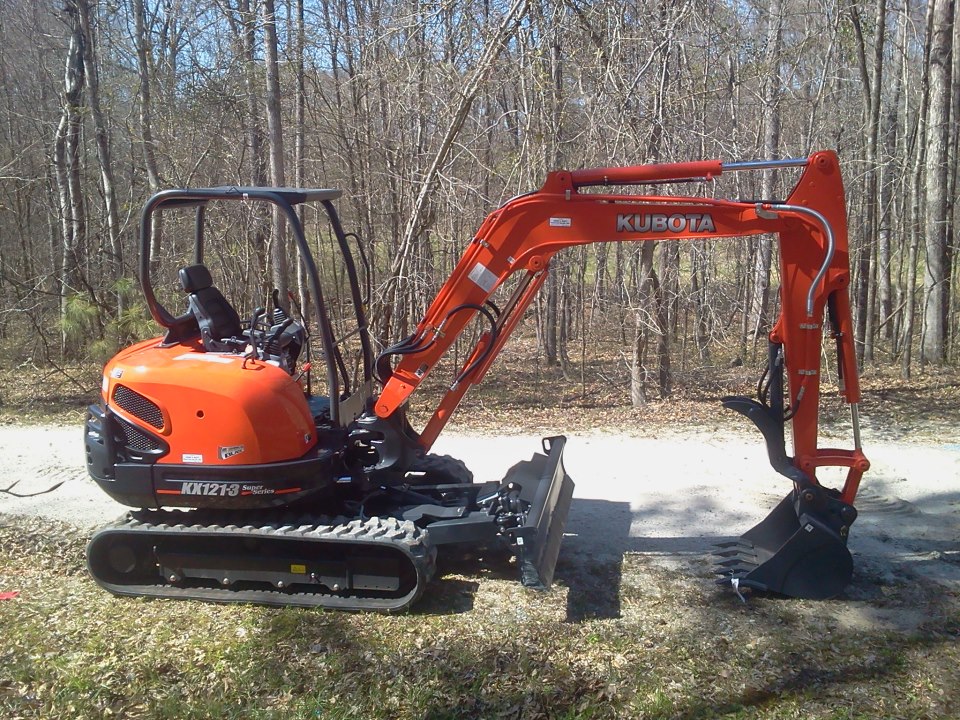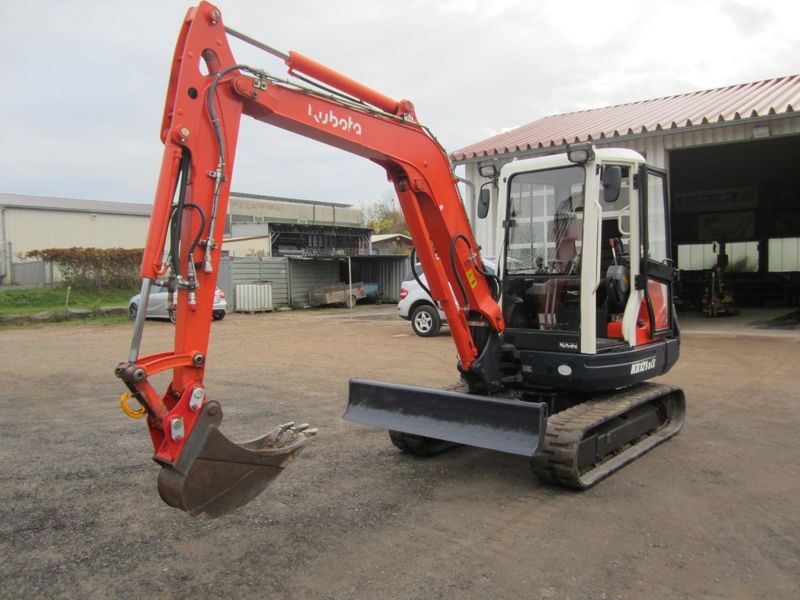kubota excavator kx 121-3 problems and solution. A few days ago, I had the engine and the right rear tire assembly replaced on my Kubota KX121-3 mini excavator. I figured it would be a good idea to update everyone on the progress of my learning curve with this piece of machinery, so here goes.
check the kubota excavator kx 121-3 thumb control valve to be in neutral when its neuter
This is a common problem on the Kubota Mini Excavators. If you have a thumb attachment, or even if you don’t, you need to make sure your thumb control valve is set in neutral when its not being used. If you don’t they will actually wear down your hydraulic cylinders on the excavator and eventually it will lead to hydraulic cylinder failure. The thumb control valve works off of the main hydraulic pump so when its activated, it pulls from the main pump which is what causes that added wear and tear on your cylinders.
The good news is that it’s very easy to fix. Just check to make sure there is no pressure on your thumb control valve by using your thumb to push it in and out of position before starting the machine.

make sure the kubota excavator kx 121-3 thumb valves are not stuck or binding
I am having problems with my Kubota KX 121-3 excavator thumbs. The hydraulic cylinders on the thumb are binding and not allowing the thumb to open properly. The problem is intermittent however, sometimes it works just fine for a few minutes and then stops working again. Sometimes it will work okay for a day or two and then start acting up again. When we have trouble with the thumbs, if I turn off the machine, remove the hoses from both of the cylinders and cycle them manually with a hammer it seems to help some but its only a temporary fix. I’ve checked all the hoses and they seem okay but when we had it in our local Kubota dealership they replaced some hoses that were hard to see because they were so close together. The problem still persists though.
One thing I noticed is that even though I cycle the valves manually there seems to be air in the lines somewhere because after cycling them with a hammer there are still bubbles in each cylinder when I try to use them again.
Check for any pressure relief valves on the kubota excavator kx 121-3 hydraulic pumps and tanks
As with the non-hydraulic systems, you need to check for pressure relief valves. The hydraulic system is pressurized, and it’s important to make sure there aren’t any leaks or cracks in the system that would prevent the system from working properly.
As with any type of equipment, you should always be prepared for any problems that may occur. Having an emergency plan can save you a lot of time and money if you have to take your machine out of service because of a problem.
The Kubota Excavator KX 121-3 has a wide range of products available to suit your needs. If you are in need of a machine that can handle heavy loads, then this machine is the one for you. It has many features that will help you get the job done right, but there are also some things that you should keep in mind when using it so you don’t damage or break anything on it.
If you’re looking for an excavator that can handle heavy loads, then this Kubota Excavator KX 121-3 model might be just what you’re looking for. It has a large amount of space.
make sure the oil is at proper levels and no leaks or air in kubota excavator kx 121-3 system
In some instances a fault with the system can cause the engine to lose power and even cut out. One of the most common causes of this is a fuel leak which can drain the tank or cause a fire. A lack of power may also be due to problems with the fuel pressure regulator or injectors, which are both essential for delivering the correct amount of fuel to the engine at the right time.
A blocked fuel filter may prevent diesel from entering the engine, meaning that it does not get enough fuel to start up. If there is air in the injection system, which can happen if there are leaks in hoses or joints, this will also cause problems starting up.
Another common problem with diesel engines is when they do not run smoothly. The engine may shudder or misfire, which is caused by either too much or too little fuel being delivered. Again this could be caused by a blockage in the filter, or a leak in a hose or pipe carrying diesel to the engine. It may also be due to incorrect timing of fuel delivery, which can be caused by problems with sensors and other components in this system on your Kubota excavator KX 121-3.
check the kubota excavator kx 121-3 thumb cylinder for leaks, rusting or binding of the cylinder rods
It’s not uncommon for you to have a cylinder leak and not notice it because the fluid is forcing it’s way out of the cylinder so slow that you don’t see it. But when this happens, the cylinder will overheat and cause premature failure.
The best way to check for leaks is with soap and water. Fill up a spray bottle with dish soap and water and spray down the cylinder. If there are any leaking points, you should see bubbles forming from where the air is escaping from the cylinder.
Another common issue with cylinders is rusting of the rod or piston. When this happens, it can cause binding of the cylinder rods. To check for this, simply pull out the rod on your cylinder as far as it will go and then push in on it to see if there is any resistance or binding. You should be able to push in on it without issue. It shouldn’t take much force.

Test for a pressure loss in the kubota excavator kx 121-3 cylinder tubing – bleed air from lines if needed
The hydraulic cylinder on a Kubota excavator needs to be bled when it is low on hydraulic fluid, or if the hydraulic fluid has been drained from the cylinder. The system needs to be primed before the excavator can be used again and this process must be done manually as there is no automatic purge cycle in a Kubota excavator.
Park the Kubota excavator on level ground, making sure that it is out of range of any overhead obstructions, such as power lines, before attempting to operate the machine.
Place the equipment in neutral and lower the bucket into the ground until it is resting on the earth below.
Turn off all auxiliary controls and remove any attachments from the machine before bleeding the cylinders.
Start up the engine and turn off any exterior lights that may have been left on by mistake.
